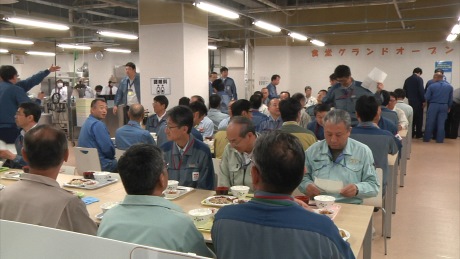Conditions and safety the focus at Fukushima site
28 August 2015
Radiation levels have reduced to the point that full-face masks are not needed for 90% of the Fukushima Daiichi site but worker safety remains a high priority following a fatal accident this month.
Tokyo Electric Power Company (Tepco) announced positive comments from its independent Nuclear Reform Monitoring Committee after a quarterly progress report. The company has made progress in processing highly contaminated water, with only a small amount remaining to be dealt with when now-unneeded storage tanks are dismantled. Without the former volumes of contaminated water on site, ambient radiation has reduced significantly, said Tepco.
A second major step regarding contaminated water was the sealing of vertical shafts in the trenches running under units 2 and 3, enabling Tepco to pump out the highly contaminated water in one of them. These complicated trenches flooded during the long accident sequence and were the source of some of the most significant leaks to sea.
"We applaud each milestone Tepco has reached steadily," said reform committee chairman Dale Klein, adding, "and all the efforts provide a strong foundation on which to build as the decommissioning work continues."
 |
| Decommissioning workers eat in their new rest house (Image: Tepco) |
This week, Japan's Ministry of Health, Labour and Welfare dispatched new rules to Tepco to help it maintain worker safety. The Japanese Atomic Industrial Forum's publication Atoms in Japan said the guidelines contain seven key items that new workers must be taught, including the use of protective equipment, personal radiation dose meters, the management of radiation dose, measures to prevent contamination, decontamination measures, first aid, and the dangers of working while wearing protective masks and suits.
The reduction in ambient radiation, and the progress of general clean-up and management of dust has meant that workers now only need full-face masks for 10% of the Fukushima Daiichi site. Using only half-face masks represents a significant improvement to the working lives of clean-up staff, which also helps them to work safely by improving their comfort and vision.
The complexity of the site, the thousands of workers and the burden of needing protective equipment combine to add risk to work at Fukushima Daiichi and there have been a number of fatal accidents. The most recent was on 8 August when workers were cleaning a vacuum truck and preparing it for return to a hire company by removing stickers and cleaning the inside of its tank. An operator checked that others were in safe positions before announcing he would close the hydraulically operated lid at the rear of the truck. However, unaware of this, the victim was moving around the other side of the truck towards its rear. He was crushed by the closing lid and died in hospital around two hours later. An investigation by Tepco has resulted in new procedures that mean workers using such equipment will collaborate to maintain sight of all others at all times.
A further improvement for workers has been a nine-storey rest building that came into operation in July offering spaces to relax and socialise, as well as a high-capacity canteen serving up to 3000 hot meals per day. It employs around 100 local people, while the food is locally sourced and cooked before being delivered by insulated van. Tepco said the new facility is "expected to improve morale and, by providing more rested and focused workers, overall safety for the decommissioning work."
Researched and written
by World Nuclear News